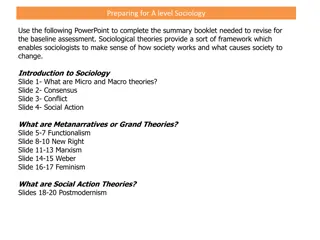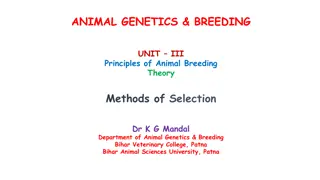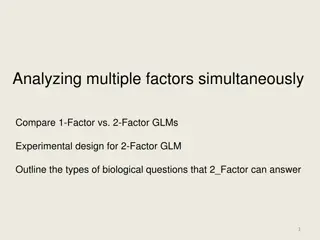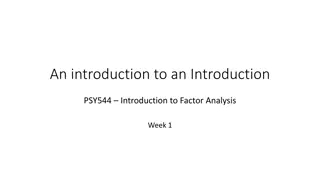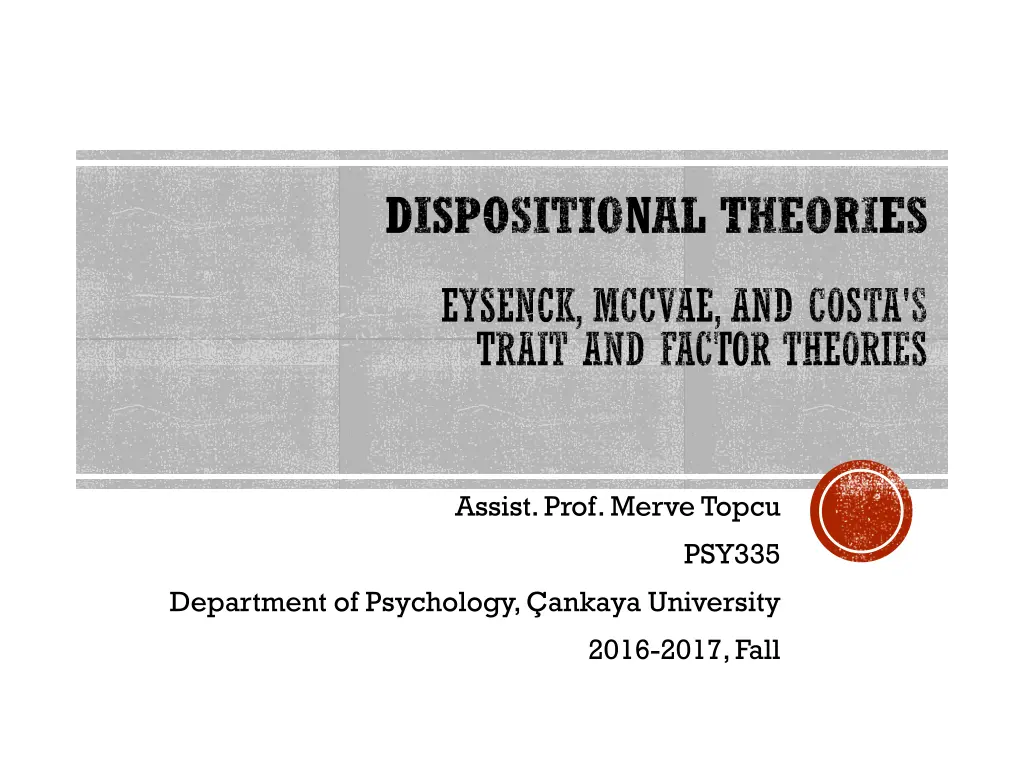
Understanding Dispositional Theories in Personality Psychology
Explore the key concepts of dispositional theories in personality psychology, including Eysenck's, McCrae's, and Costa's trait and factor theories. Learn about measuring personality, the number of traits individuals possess, Cattell's trait theory, basics of factor analysis, and more.
Download Presentation

Please find below an Image/Link to download the presentation.
The content on the website is provided AS IS for your information and personal use only. It may not be sold, licensed, or shared on other websites without obtaining consent from the author. If you encounter any issues during the download, it is possible that the publisher has removed the file from their server.
You are allowed to download the files provided on this website for personal or commercial use, subject to the condition that they are used lawfully. All files are the property of their respective owners.
The content on the website is provided AS IS for your information and personal use only. It may not be sold, licensed, or shared on other websites without obtaining consent from the author.
E N D
Presentation Transcript
DISPOSITIONAL THEORIES EYSENCK, MCCVAE, AND COSTA'S TRAIT AND FACTOR THEORIES Assist. Prof. Merve Topcu PSY335 Department of Psychology, ankaya University 2016-2017, Fall
TRAT AND FACTOR THEORES N GENERAL How can personality best be measured? How many traits or personal dispositions does a single person possess? Allport found nearly 18,000 trait names in an unabridged English language hctionary Eysenck insisted that only three major factors Extraversion / introversion Neuroticism / stability Psychoticism / superego For contemporary theorists five is the magic number The Five-Factor Theory Neuroticism & Extraversion Openness to experience, agreeableness & conscientiousness
TRAT AND FACTOR THEORES Cattell's trait theory enhances the understanding of Eysenck's three-factor theory Different each other in terms of Reasoning Theory Methodology Assessment Classification of traits
BASCS OF FACTOR ANALYSS Correlation coefficient A mathematical procedure for expressing the degree of correspondence between two sets of scores Factor analysis can account for a large number of variables with a smaller number of more basic dimensions = traits Factors represent a cluster of closely related variables Factor loadings the extent to which each individual score contributes to the various factors Traits generated through factor analysis Unipolar traits are scaled from zero to some large amount. Height, weight, and intellectual ability Bipolar traits extend from one pole to an opposite pole, with zero representing a midpoint Introversion versus extraversion
BASCS OF FACTOR ANALYSS In order for mathematically derived factors to have psychological meaning, the axes on which the scores are plotted are usually turned or rotated into a specific mathematical relationship with each other. Orthogonal rotation Oblique method
EYSENCK'S FACTOR THEORY Has strong psychometric and biological components Psychometric findings are meaningless unless they have been shown to possess a biological existence 1. Psychometric evidence for the factor's existence must be established Other investigators from separate laboratories, must also be able to find the factor 2. The factor must also possess heritability and must fit an established genetic model eliminates learned characteristics, such as the ability to mimic the voices of well-known people or a religious or political belief 3. The factor must make sense from a theoretical view. Eysenck employed the deductive method of investigation, beginning with a theory and then gathering data that are logically consistent with that theory. 4. A factor must possess social relevance have a r/ship with such socially relevant variables as drug addiction, proneness to unintentional injuries, outstanding performance in sports, etc.
Specific acts or cognitions May or may not be characteristic of a person "important seem- permanent personality dispositions" Four - level hierarchy of behavior organization Habitual acts / cognitions Recur under similar conditions
DIMENSIONS OF PERSONALITY Cattell's 35 traits are all third level of the hierarchical structure, whereas Eysenck's superfactors are at the fourth level. Five-and no more and no fewer-general factors will emerge from nearly all factor analyses of personality traits
DIMENSIONS OF PERSONALITY Eysenck regarded all three factors as part of normal personality structure. All three are bipolar Introversion vs. extraversion Neuroticism vs. stability Psychoticism vs. Superego A strong biological base exists for each of his three superfactors Agreeableness & conscientiousness do not have an underlying biological foundation 3 factors relate to such social issues as drug use, sexual behaviors, criminality, preventing cancer & heart disease, & creativity.
DIMENSIONS OF PERSONALITY Extraversion characterized primarily by sociability and impulsiveness jocularity, liveliness, quick-wittedness, optimism rewarded for their association with others Introversion quiet, passive, unsociable, careful, reserved, thoughtful, pessimistic, peaceful, sober, and controlled the primary cause of differences between extraverts and introverts is one of cortical arousal level Extraverts have a lower level of cortical arousal than do introverts have higher sensory thresholds and thus lesser reactions to sensory stimulation To maintain an optimal level of stimulation, introverts, with their congenitally low sensory threshold, avoid situations that will cause too much excitement.
DIMENSIONS OF PERSONALITY Neuroticism / Stability a tendency to overreact emotionally and to have difficulty returning to a normal state after emotional arousal frequently complain of physical symptoms People can score high on neuroticism and be free of any debilitating psychological symptoms. a genetic basis for such neurotic traits as anxiety, hysteria, and obsessive- compulsive disorders. Related to antisocial and asocial behaviors such as adult crime, childhood behavior disorders, homosexuality, and alcoholism
DIMENSIONS OF PERSONALITY The diathesis-stress model of psychiatric illness the higher the neuroticism score, the lower the level of stress necessary to precipitate a neurotic disorder. Eysenck's factor analytic technique assumes the independence of factors depending on their degree of introversion or extraversion, people can display quite different symptoms Normal distribution As scores move toward the outer limits of the diagram, they become Increasingly less frequent, just as scores on the ends of a curve are less frequent than those near the midpoint.
DIMENSIONS OF PERSONALITY Psychoticism / Superego often egocentric, cold, nonconforming, impulsive, hostile, aggressive, suspicious, psychopathic, and antisocial low on psychoticism (in the direction of superego function) tend to be altruistic, highly socialized, empathic, caring, cooperative, conforming, and conventional People who score high on psychoticism and who are also experiencing levels of stress have an increased chance of developing a psychotic disorder. High P scorers are genetically more vulnerable to stress than are low P scorers.
DIMENSIONS OF PERSONALITY IN TURKISH CULTURE NegativeValence / Olumsuz De erlik (Gen z & nc l, 2012) Specific to Turkish culture Negative self-attributions
DIMENSIONS OF PERSONALITY IN TURKISH CULTURE D a D n kl k e D n kl k (Extroversion Introversion) 8 adet s fat Sorumluluk (Conscientiousness) 9 adet s fat Uyumluluk (Agreeableness) 9 adet s fat N rotisizm Duygusal Tutarl k (Neuroticism Emotional Stability) 9 adet s fat A kl k / Ak l (Openness / Intellect) 6 adet s fat Olumsuz De erlik (NegativeValence) 6 adet s fat (Gen z & nc l, 2012)
MEASURING PERSONALITY The Maudsley Personality Inventory E & N factors, but correlated The Eysenck Personality Inventory L scale E & N, independently extended to children 7 to 16 years of age Temel Ki ilik zellikleri l e i (Gen z & nc l, 2012)
DIMENSIONS OF PERSONALITY IN TURKISH CULTURE EXTRAVERSION (d ad n kl k) ( = .89) ine kapan k (ters) ekingen (ters) Durgun (ters) Utanga (ters) Konu kan Pasif (ters) So uk (ters) giri ken NEUROTICISM (duygusal tutars zl k) ( = .83) Al ngan Agresif Sinirli K zg n Sab rs z Aceleci Kaprisli Huysuz Kayg l OPENNESS TO EXPERIENCE (geli ime a kl k/ak l) ( = .80) Kabiliyetli Yarat c Kendine g venen Kendinden emin Cesur Geni -rahat (Gen z & nc l, 2012)
NEGATIVE VALENCE (olumsuz de erlik) ( = .71) Yapmac k Terbiyesiz ten pazarl kl G rg s z A g zl Sabit fikirli AGREEABLENESS (ge imlilik/uyumluluk) ( = .85) Canayak n Yard msever Ho g r l yi niyetli Sevecen ten Payla mc Duyarl CONSCIENTIOUSNESS (sorumluluk) ( = .85) Disiplinli D zenli Tedbirli al kan Titiz Azimli Sorumsuz (ters) enge (ters) (Gen z & nc l, 2012)
BIOLOGICAL BASES OF PERSONALITY Eysenck estimated that about three fourths of the variance of all three personality dimensions can be accounted for by heredity and about one fourth by environmental factors Finding nearly identical factors among people in various parts of the world tend to maintain their position over time on the different dimensions of personality Twin studies Psychoticism, extraversion, and neuroticism have both antecedents and consequences The antecedents are genetic and biological The consequences include such experimental variables as conditioning experiences, sensitivity, and memory as well as social behaviors such as criminality, creativity, psychopathology, and sexual behavior
The psychometric traits of P, E, and N can combine with one another and with genetic determinants, biological intermediates, and experimental studies to predict a variety of social behaviors, including those that contribute to disease.
PERSONALITY & BEHAVIOR Do Eysenck's three general personality dimensions predict behavior? An effective theory of personality should predict both proximal and distal consequences Many psychology studies have reached erroneous conclusions because they have ignored personality factors Psychoticism (P) is related to genius & creativity Both high P scorers and high E scorers are likely to be troublemakers as children
PERSONALITY & DISEASE Can personality factors predict mortality? People who scored low on neuroticism (N) on the Maudsley Personality Inventory tended to suppress their emotion and were much more likely than high N scorers to receive a later diagnosis of lung cancer. Diseases are caused by an interaction of many factors. factors include family history, age, gender, ethnic background, hypertension, unfavorable ratio of total cholesterol to high density lipoprotein (HDL), smoking, diet, inactive lifestyle, and several personality factors. when it is combined with stress and personality factors, it helps contribute to death
TAXONOMY / THEORY Taxonomy as a classification of things according to their natural relationships. essential starting point for the advance of science, but that they are not theories Whereas theories generate research, taxonomies merely supply a classification system. Eysenck's three-factor approach is a good example of how a scientific theory can use a taxonomy to generate hundreds of hypotheses. McCrae and Costa's Five-Factor Model (FFM) Identify basic personality traits as revealed by factor analysis Evolved into a taxonomy & the five-factor model Model became a theory, one that can both predict and explain behavior.
FIVE-FACTOR MODEL Costa & McCrae Using factor analytic techniques to examine the stability and structure of personality. Focused initially on the two main dimensions of newoticism and extraversion. Also, found openness to experience Although Lewis Goldberg had first used the term "Big Five" in 1981 to describe the consistent findings of factor analyses of personality traits, Costa and McCrae continued their work on the three factors. With the dozens of different personality inventories and hundreds of different scales, how was a common language to emerge? the five factors show some permanence with age
FIVE-FACTOR MODEL Agreed with Eysenck that personality traits are bipolar and follow a bell-shaped distribution.
FIVE-FACTOR THEORY Turn the Five-Factor Model (taxonomy) into a Five-Factor Theory (FFT) The five factors constituted noting more than a taxonomy, a classification of basic personality traits found a stable structure of personality A new theory should be able to incorporate the change and growth of the field that has occurred over the last 25 years be grounded in the current empirical principles that have emerged from research.
FIVE-FACTOR THEORY Assumptions the central or core components are represented by rectangles, the peripheral components are represented by ellipses The arrows represent dynamic processes and indicate the direction of causal influence Biological bases are the sole cause of basic tendencies The personality system can be interpreted either cross-sectionally or longitudinally Each causal influence is dynamic,changes over time
FIVE-FACTOR THEORY Three central components of the theory Basic tendencies 1. Characteristic adaptations 2. Self-concept 3.
FIVE-FACTOR THEORY Basic tendencies the central components of personality Characteristic adaptions Self-concept Biological bases Objective biography (life experiences) External influences ...may be inherited,imprinted by early experience or modified by disease or psychological intervention, but at any given period in an individual's life, they define the individual's potential and direction. include cognitive abilities, artistic talent, sexual orientation, and the psychological processes underlying acquisition of language.
FIVE-FACTOR THEORY Basic tendencies (cont d) Basic tendencies have four postulates 1. Individuality a unique set of traits each person exhibits a unique combination of trait patterns 2. Origin All personality traits are the result solely of endogenous (internal) forces, such as genetics,hormones, and brain structures The family environment plays no role in creating basic tendencies 3. Development traits develop and change through childhood, but in adolescence their development slows, and by early to mid-adulthood change in personality nearly stops altogether 4. Structure traits are organized hierarchically from narrow and specific to broad and general
FIVE-FACTOR THEORY Characteristic Adaptations Acquired personality structures that develop as people adapt to their environment. Whereas basic tendencies are quite stable, characteristic adaptations can be influenced by external influences, such as Acquired skills E.g., Language or statistics How quickly we learn (talent, intelligence, aptitude) is a basic tendency; what we learn is a characteristic adaptation Habits Attitudes R/ships that result from the interaction of individuals w/ their environment differ from culture to culture
FIVE-FACTOR THEORY Characteristic Adaptations (cont d) Over time, people adapt to their environment by acquiring patterns of thoughts, feelings, and behaviors that are consistent with their personality traits and earlier adaptations Our responses are not always consistent with personal goals or cultural values E.g., when introversion is carried to extreme, it may result in pathological social shyness Basic traits may "change over time in response to biological maturation, changes in the environment,or deliberate interventions Behavior modification may have a difficult time changing a person's fundamental traits, but they may be potent enough to alter a person's characteristic responses
FIVE-FACTOR THEORY Self-concept Self-concept is actually a characteristic adaptation, but it gets its own box because it is such an important adaptation. consists of knowledge, views, and evaluations of the self... The beliefs, attitudes, and feelings one has toward oneself Personal myths
FIVE-FACTOR THEORY Peripheral Components 3 peripheral components Biological bases Objective biography External influences
FIVE-FACTOR THEORY Biological bases The Five-Factor Theory rests on a single causal influence on personality traits, namely biology Environment has no direct influence on basic tendencies
FIVE-FACTOR THEORY Objective Biography Everything the person does, thinks, or feels across the whole lifespan What has happened in people's lives (events & experiences) (objective) rather than their view or perceptions of their experiences (subjective)
FIVE-FACTOR THEORY External Influences How we respond to the opportunities and demands of physical or social situations These responses are a function of two things: Characteristic adaptations 1. Their interaction w/ external influences 2.
REFERENCES Course book Gen z, T., & nc l, . (2012). Examination of Personality Characteristics in a Turkish Sample: Development of Basic Personality Traits Inventory. The Journal of general psychology, 139(3), 194-216.











